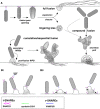Exocytosis of Weibel-Palade bodies: how to unpack a vascular emergency kit
- PMID: 30375718
- PMCID: PMC7379738
- DOI: 10.1111/jth.14322
Exocytosis of Weibel-Palade bodies: how to unpack a vascular emergency kit
Abstract
The blood vessel wall has a number of self-healing properties, enabling it to minimize blood loss and prevent or overcome infections in the event of vascular trauma. Endothelial cells prepackage a cocktail of hemostatic, inflammatory and angiogenic mediators in their unique secretory organelles, the Weibel-Palade bodies (WPBs), which can be immediately released on demand. Secretion of their contents into the vascular lumen through a process called exocytosis enables the endothelium to actively participate in the arrest of bleeding and to slow down and direct leukocytes to areas of inflammation. Owing to their remarkable elongated morphology and their secretory contents, which span the entire size spectrum of small chemokines all the way up to ultralarge von Willebrand factor multimers, WPBs constitute an ideal model system for studying the molecular mechanisms of secretory organelle biogenesis, exocytosis, and content expulsion. Recent studies have now shown that, during exocytosis, WPBs can undergo several distinct modes of fusion, and can utilize fundamentally different mechanisms to expel their contents. In this article, we discuss recent advances in our understanding of the composition of the WPB exocytotic machinery and how, because of its configuration, it is able to support WPB release in its various forms.
Keywords: Weibel-Palade bodies; endothelial cells; exocytosis; von Willebrand disease; von Willebrand factor.
© 2018 The Authors. Journal of Thrombosis and Haemostasis published by Wiley Periodicals, Inc. on behalf of International Society on Thrombosis and Haemostasis.
Conflict of interest statement
The authors state that they have no conflict of interest.
Figures





Similar articles
-
A new look at an old body: molecular determinants of Weibel-Palade body composition and von Willebrand factor exocytosis.J Thromb Haemost. 2024 May;22(5):1290-1303. doi: 10.1016/j.jtha.2024.01.015. Epub 2024 Feb 1. J Thromb Haemost. 2024. PMID: 38307391 Review.
-
Functional architecture of Weibel-Palade bodies.Blood. 2011 May 12;117(19):5033-43. doi: 10.1182/blood-2010-09-267492. Epub 2011 Jan 25. Blood. 2011. PMID: 21266719 Free PMC article. Review.
-
Tuning the endothelial response: differential release of exocytic cargos from Weibel-Palade bodies.J Thromb Haemost. 2018 Sep;16(9):1873-1886. doi: 10.1111/jth.14218. Epub 2018 Aug 12. J Thromb Haemost. 2018. PMID: 29956444 Free PMC article.
-
Weibel-Palade Body Localized Syntaxin-3 Modulates Von Willebrand Factor Secretion From Endothelial Cells.Arterioscler Thromb Vasc Biol. 2018 Jul;38(7):1549-1561. doi: 10.1161/ATVBAHA.117.310701. Epub 2018 Jun 7. Arterioscler Thromb Vasc Biol. 2018. PMID: 29880488 Free PMC article.
-
Weibel-Palade bodies at a glance.J Cell Sci. 2017 Nov 1;130(21):3611-3617. doi: 10.1242/jcs.208033. Epub 2017 Nov 1. J Cell Sci. 2017. PMID: 29093059 Review.
Cited by
-
Blood failure: traumatic hemorrhage and the interconnections between oxygen debt, endotheliopathy, and coagulopathy.Clin Exp Emerg Med. 2024 Mar;11(1):9-21. doi: 10.15441/ceem.23.127. Epub 2024 Mar 21. Clin Exp Emerg Med. 2024. PMID: 38018069 Free PMC article.
-
VWF-ADAMTS13 axis dysfunction in children with sickle cell disease treated with hydroxycarbamide vs blood transfusion.Blood Adv. 2023 Nov 28;7(22):6974-6989. doi: 10.1182/bloodadvances.2023010824. Blood Adv. 2023. PMID: 37773926 Free PMC article.
-
Dispatch and delivery at the ER-Golgi interface: how endothelial cells tune their hemostatic response.FEBS J. 2022 Nov;289(22):6863-6870. doi: 10.1111/febs.16421. Epub 2022 Mar 10. FEBS J. 2022. PMID: 35246944 Free PMC article.
-
Trauma-induced coagulopathy.Nat Rev Dis Primers. 2021 Apr 29;7(1):30. doi: 10.1038/s41572-021-00264-3. Nat Rev Dis Primers. 2021. PMID: 33927200 Free PMC article. Review.
-
Plasma membrane phosphatidylinositol (4,5)-bisphosphate promotes Weibel-Palade body exocytosis.Life Sci Alliance. 2020 Aug 21;3(11):e202000788. doi: 10.26508/lsa.202000788. Print 2020 Nov. Life Sci Alliance. 2020. PMID: 32826291 Free PMC article.
References
Publication types
MeSH terms
Substances
Grants and funding
LinkOut - more resources
Full Text Sources
Other Literature Sources

